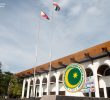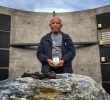In one of their stories of long ago, the Mansaka, an indigenous tribe from the provinces of Davao del Norte and Compostela Valley, once possessed a golden guitar, which they played when they sang their songs of longing, aspirations and victory.
But as time went by, they realized that nobody appreciated their songs anymore, so they hurled the guitar into the deepest part of the sea. Now they can only sit and look at the sea, towards the place where they hurled their guitar.
The story of the Mansaka�s golden guitar is only one of the epics of the Lumads (a collective term for the indigenous peoples of Mindanao) that speak of golden objects.
A mining tunnel in Diwalwal, a gold rush area in Compostela Valley.
According to Dr. Carmen Unabia, former dean of Central Luzon State University in Munoz in Nueva Ecija, golden objects pepper the folklore of the Lumad.
Unabia, who recently guested an afternoon of storytelling at the Museo Dabawenyo, said she came upon these stories from the Lumad elders she had spoken with for her graduate and doctorate degrees. She believes that the presence of gold in Lumad literature depicts a history of abundance of the precious mineral. “It revealed that, sometime in their lives, they were rich in gold,” she said.
A Nanangon folktale, which forms part of the oral literature of Bukidnon, also mentioned gold. This was particularly true in the story of a monkey who wanted to marry the king’s daughter. The king, of course, did not want the monkey to marry his daughter but instead of refusing him outright, the king put up tests and obstacles in the hope that the monkey would give up.
But the monkey was able to complete the tasks. Finally, the king gave the final test. He wanted to wake up the next morning to find his surroundings turned into gold. Thinking that he had finally driven the monkey away, the king woke up the next morning to see that all the trees, all the mountains have turned into gold. The king had no choice but to marry off his daughter.
On the day of the wedding, the king — and the princess — were surprised to find out that the monkey was actually the brave and handsome warrior Bataay in disguise.
But back then, gold was not the medium of exchange, Unabia said. “It could not buy even a single tomato,” she said. The Lumads learned to value gold because it made objects glitter and look more special. Since gold was abundant, they used the attractive metal to decorate everyday objects — furniture, machete handles, stairs, and even handkerchiefs.
Unabia said the Subanons from the Zamboanga Peninsula speak of a princess who desperately wanted to send a message to her husband fighting in a battle across the ocean. With no mobile phone at that time, she spoke to her golden handkerchief and let it fly across the waters. The handkerchief brought her message to her husband.
Other Lumad stories depicted everyday objects made of solid gold or gold trimmed. They all showed the role that the precious metal played in the lives of the Lumad. “Anything that is glorified is always likened to gold,” Unabia said.
When the Chinese arrived, the Lumads traded what they had for large porcelain jars. “These were very useful to them during rituals,” explained Unabia. “Wine had to made months before in order to have time to ferment and the Lumads needed a large container for this. But these jars seemed very plain so they painted them with gold.”
Unabia also recounted that the handle of the dagger of Alisngangan, the bravest man in the Subanun legends, was made of gold. The legendary warrior’s body did not have curves but edges — from the daggers that he had swallowed.
Among the Lumad stories was the golden spaceship — yes, spaceship — piloted by Datu Malagunot used to transport the virtuous souls up into heaven.
Unabia said she expects people to be skeptical about these stories. “Literature is only a representation, a symbolic representation of what is happening in the people’s lives,” she explained.
She said it was up to the people if they wanted to fathom the relevance, the truth behind the stories. “If it is precious, look for what makes it precious.”
Unabia’s storytelling session was sponsored by the provincial government of Compostela Valley. She told province, which is making a lot of money out of gold, “Remember to help the (Lumad).� (CJ Kuizon/ davaotoday.com)










